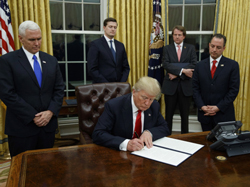President Trump issued an executive order on Thursday, Oct. 12 which he believes will help mitigate adverse consequences of the PPACA— Patient Protection and Affordable Care Act — such as the high premiums and deductibles, and the minimal options in selecting plans.
This follows the unsuccessful efforts to “repeal and replace” the PPACA by Republicans in Congress.
The promise to overturn the PPACA has been a Republican cornerstone, and the Democrats have been steadfast in their opposition.
Vertiginous squabbling and partisan gridlock has led to no compromise in our Congress.
As a result, no substantive measures have been made to improve the PPACA and bring costs of healthcare down; instead, many Republicans have called for scrapping it altogether and a third of Democrats have advocated for opting to a single-payer “Medicare for All”. Until the PPACA can be improved, the President has issued an executive order interim.
According to the Office of the White House Press Secretary, the executive order allows small-business employers to buy into association health plans, which would allow them to collectively self-insure or purchase group insurance—spreading the costs and allowing for lower payments for individuals within the group. Additionally, the executive order enables individuals to purchase health insurance “across state lines”.
Amy Mader, a senior history major at Monmouth, says “I’m more in favor of a [single-payer] system…I am not sure how well [allowing individuals to purchase healthcare across state lines] would work.” Indeed, purchasing a plan from another state’s insurer would inevitably create more national competition, and possibly lower costs as a result.
However, the ethical implications of this may not fare too well. For example, if a New Jersey resident purchases health insurance from Arizona, she/he may have to fly to Arizona in order to see her/his doctor if only Arizona hospitals and doctors accept Arizona health insurance.
The executive order also eliminates the federally-funded cost-sharing subsidies, which many detractors have called “bailouts to health insurance companies”. However, on Friday, Oct. 13, America’s Health Insurance Plans and Blue Cross Blue Shield Association released a joint statement saying there would be “real consequences” to ending these subsidies: the health-insurance marketplace would destabilize, causing consumers’ choices to shrink and costs to rise.
The PPACA—or more colloquially called “Obamacare”—provides, what are called, “cost-sharing reduction” payments to approximately 7 million low-income Americans.
These payments help to offset insurance deductibles and other out-of-pocket expenses for those aforementioned individuals and families. According to the Washington Post, insurers are required to provide the appropriate discounted prices for eligible customers. However, ending the payments give warrant for any insurance company to opt out of its federal contract to sell those specific healthcare plans starting in 2018.
Moreover, because federal tax credits for many Americans covered under the PPACA rise when their premiums increase, eliminating these payments would actually increase taxpayer costs by $6 billion in 2018 and $21 billion by 2020— the non-partisan Congressional Budget Office (CBO) projects.
The CBO also said that although the “slightly higher number of uninsured” would be temporary, “5 percent of people live in areas that would have no insurers” next year if subsidies ended.
However, it estimated that the uninsured rate would be “slightly lower” by 2020: as more Americans could take advantage of more generous premium tax credits.
Under Title I of the PPACA, Short-Term, Limited-Duration Insurance (STLDI) plans are exempt from the regulated exchanges. The president’s executive order would eliminate this exemption and allow individuals to purchase STLDI.
However, critics argue this could potentially lure younger, healthier consumers from Obamacare exchanges for cheaper and skimpier policies—leaving sicker and older consumers to pick up the tab with higher premiums on their exchanges.
In addition to making healthcare more affordable and accessible, it is also imperative to stress the importance of preventive care. “Having experience in healthcare, I have seen a great number of people delaying care due to lack of medical coverage,” Polina Amburg, a specialist professor of the Nursing Department at Monmouth, says, “In many cases, people sought medical attention when their conditions were too severe.”
“Unfortunately, by saving money on cutting preventative service the government loses money on the cost of care for the management of disabilities resulting from untreated conditions,” Amburg notes.
“For example, a person with early signs of diabetes, if identifies and managed on time, could live a productive life and never develop disease complications,” she adds, “On the other hand, if not managed, diabetes could lead to a serious disability…”
“All of those complications could have been averted with basic screening and early interventions,” Amburg stresses.
IMAGE TAKEN from thumbs.mic.com


